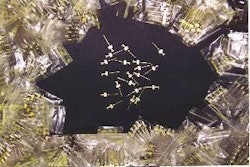
Mycotoxins are 'signature' chemicals for specific field fungal pathogens and storage moulds. Pigs are more sensitive to a wider range of mycotoxins at lower concentrations than most other livestock. Different mycotoxins often occur together. Presence of one can be used as a ‘testing marker' for others from the same or closely related fungi for example, deoxynivalenol (DON) and zearalenone (ZEA) found on wheat and maize.
The production of these toxins depends on ambient temperature and moisture levels (relative humidity, surface water and grain moisture content) affecting the infection, growth and spread of moulds. Blending and mixing of feed materials prone to contamination by different mycotoxins, such as soybean (aflatoxin) and wheat (DON), expand the hazard horizon. Toxicological synergism produces a combined toxicity from 2 or more mycotoxins that is greater than the simple additive effect. Synergism between DON and fusaric acid affects young pigs; testing for both mycotoxins in suspect feeds is advised.
Field mycotoxins are produced by strong fungal parasites on standing crops, e.g. DON and ZEA by several species of Fusarium causing scab and ear blight in wheat. Storage mycotoxins are synthesised by weakly parasitic or saprophytic fungi, such as the ochratoxin A (OTA) producing mould Pencillium verrucosum on stored wheat grain. Some storage moulds can infect developing cereal grains in the field.
Killing the fungal source may not solve the problem because mycotoxins persist long after the fungus has disappeared. There is no magic cure. Avoidance and prevention are safer and surer than detoxifying the chemical or locking up' its action. Integrated action on fungus and toxin from field crop to pig feeding is required, with manipulation of pig nutrition to bolster body metabolism.
Action plan: Establish preventive measures using hazard/risk analyses such as HACCP (Hazard Analysis Critical Control Point). Use physical and biological factors affecting mycotoxin production, commodity flow patterns and sound management practices to establish risk of contamination at specific stages along the supply chain. Accurate identification of the control points is crucial for HACCP success. Use quantitative testing to measure mycotoxin levels and assess management measures.
In the field, poor harvest conditions with cereal lodging (stalks fracture and fall over) pose the biggest threat. Grain loads with a higher incidence of broken kernels and trash are more prone to infection and contamination. Proper grain cleaning can remove infected and/or contaminated husks. Cereal by-products such as bran are invariably more contaminated than cleaned grain. Cereal harvests dried down to 11-12% w/w (weight/weight) moisture content are considered safe for grain storage and transit.
Mould starts to grow when the equilibrium moisture content (EMC) exceeds 13%. The EMC depends on temperature and relative humidity. As examples it ranges from 10.9% for wheat grain held at 25°C/50% to 13.6% at 25°C/70% and 19.7% at 25°C/90%. A drop in temperature during grain shipment and transit will cause condensation, damp grain and mould growth.
Visible mould, mustiness and caking are clear warning signs of fungal growth and contamination, but quantitative testing is the only way to identify a hazard. Mycotoxin is not randomly distributed in grain, but aggregated in damp hot spots' of mould activity. Sampling procedure is just as important as test sensitivity. Grain sampled during or after movement and mixing gives the most representative result.
For grain preservation, propionic acid (or salts) inhibits growth of most moulds, but not all of them. High concentrations are required. A low concentration may even encourage moulds which utilise the acid as a substrate. Feed transporters, bins, mixers, etc., in contact with raw materials and feed are sources of mould growth and mycotoxin contamination, unless cleaned between batches. Keep feeding equipment fresh and clean.
Feed factors: Dietary additions of nutrients and vitamins may ameliorate the effects of mycotoxins. Supplementing with protein and the sulphur-containing amino acids methionine and cysteine are specifically mentioned in this respect. Antioxidant protection of feed may also help directly and indirectly by preventing oxidative destruction of nutrients.
Deactivation by heat and chemical detoxification using ammonium hydroxide, sodium bisulphite, peroxides, ozone and chlorine have proved effective. But most processes are limited by damage to grain and feed, reduced palatability and nutritional value and safety risks to operators and livestock. Biological control, using microbes to cleave and detoxify mycotoxin molecules, offers a more targeted and safer method of decontamination. A safe strain of Eubacterium shows trichothecene-detoxifying activity and a new species of yeast (Trichosporon mycotoxinivorans) can detoxify OTA and ZEA.
Mycotoxin binders for including in feed materials have small particles, large surface areas and high adsorptive capacities. Binders lock onto mycotoxins and carry them right through the alimentary canal. Clay mineral binders like betonites, zeolites and aluminosilicates can be used. Water saturated clay molecules attract and bind polar functional groups on the mycotoxin molecule. Mycotoxin is isolated from the digestive process, preventing gut absorption, assimilation and poisoning.
Disadvantages from high feed inclusion rates of 4-10kg/ton include dilution of nutritional value. Clays do not biodegrade in manure lagoons and clay-laced excrement causes wet slippery floors with safety hazards for pigs and farm workers. Also, clay binders offer no nutritional benefit and reduce overall feed value by non-selective binding of vitamins, minerals and amino acids as well as mycotoxins. Their narrow range of mycotoxin-binding ability is essentially restricted to aflatoxin. Other mycotoxins including ZEA and OTA lack the functional polar groups required for efficient chemi-adsorption and binding. Among non-clay binders, glucan and mannan components make mannanoligosaccharide (MOS) fast-acting against a wider range of mycotoxins, notably ZEA, at low inclusion rates within a wide range of gut pH.



















